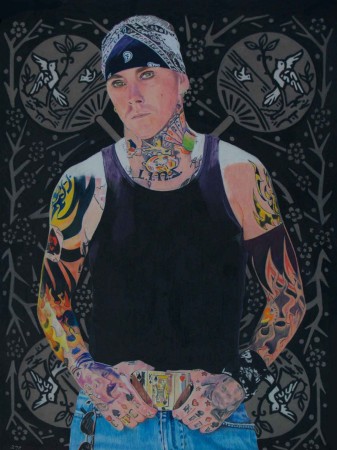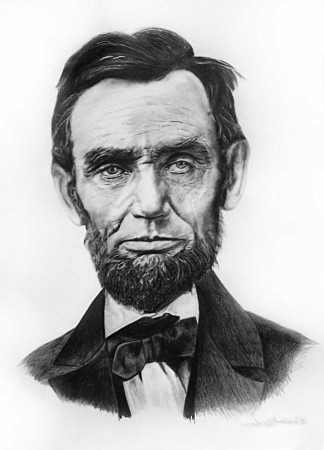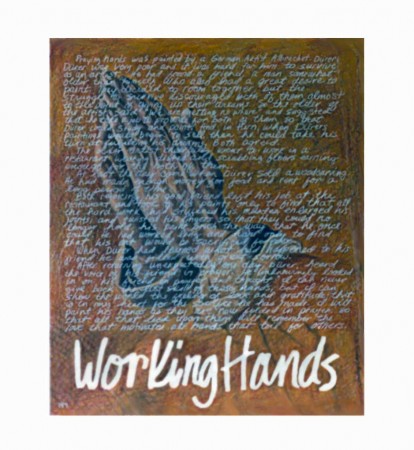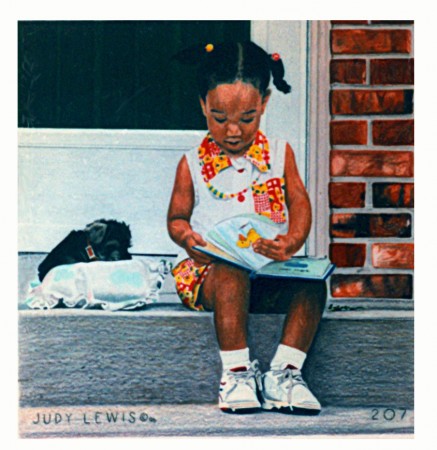
Though Monet said, “My life is useless,” artist Judy Lewis disagrees with this statement, though she can see how Monet may have felt this way. “It is a tough life to live struggling to make a living as an artist because you feel such desire and passion. If you look at art history, many artists lacked the customer base to feel appreciated during their lives,” according to Lewis, a native Clarksvillian.
Lewis, a devoted mother, has one daughter, Keegan, from a previous marriage and has lived in Clarksville for the majority of her life. In addition, Lewis has done work in Texas, and recently returned from Gettysburg, PA. Lewis has been steadily producing art work sometime after, Art Cantu, a Christian minister from south Texas, witnessed to her, and sparked a hope in her that she could achieve her dreams. At this point in her career, Lewis has done over 300 exhibit-worthy pieces, and continues to produce more art every day, not counting numerous drawings.
Of late, Lewis has delved into painting oils and acrylics with a style and color technique as unique and original as her drawings. The painting, Phoenix Rising on Angel’s Wings, captures the colors of a young girl and her gallant horse, Angel, as they properly go riding across a verdant field. Her vivid brush strokes in Christmas Carriages on Franklin Street capture the light and color of night lights downtown during a Christmas extravaganza.
Starting out, Lewis did drawings, and Christian poster art, and was always drawing more. Ms. Lewis got five commissions for her work from having her art work in a downtown window in Schumer’s. The client later told her, “You’re the best kept secret in this town.” As we sit in a local restaurant, Lewis unveils her life as a regional artist in the following interview.
At what point did you first realize you were an artist?
“I always thought I was since I was a kid—first grade—all I wanted to do when I was a kid was color. My friend would get mad at me and say, ‘all you ever do is color.’”
“But it goes earlier than that. In my grandmother’s Bible there were real, detailed paintings in between each book of the Bible, and woodcuts in the appendixes. I was around four or five at the time. I remember while I was redrawing them, the thought came to me–maybe I want to be an artist? At that moment something inside me said that I wanted to be an artist. Growing up, I got in trouble in school a lot for drawing in class.”
Could you tell us some more about your work?
“I mostly do portraiture. I do love to do portraits of people. Norman Rockwell was a storyteller, but feel that I can capture a feeling like the innocence of childhood. Say I had twenty studies of a child’s portrait but there was only one that captured my heart. That’s when I know it’s going to be a good portrait, and my goal is to pay tribute to that person the best I possibly can.”

One of my favorite pieces that you’ve done is the portrait of Abraham Lincoln. Is that the case with this historical piece too?
“Yes, I wanted to portray Abraham Lincoln as best I can. I loved going to the Smithsonian and seeing the presidential portraits, but Lincoln was the first one I wanted to draw. Also, because I was in Gettysburg, it was right to do him and I’m glad I did.”
What about doing portraits of historical figures and celebrities?
“I’d like to do Joan of Arc’s portrait! I’d also like to do Wilma Rudolph, Frank Sutton, Sgt. Carter from Gomer Pyle, [because] he’s from Clarksville—anyone from Clarksville who was well known, or celebrities.”
Why Joan of Arc?
“Because she’s an interesting character in history. You don’t see a lot of portraits of great women, since it’s been a men’s world.”
Which five artists would you like to be stranded with on a deserted island? You know—the art world’s version of Lost?
“Van Gogh, Renoir, Norman Rockwell, da Vinci, and Michelangelo. I’ve read a lot of van Gogh—his life was depressing but interesting. Other artists I like are Sargent. Rockwell is number one for me. The art world didn’t consider him [because] he was more of an illustrator but an illustrator is still an artist. And I like Norman Rockwell’s portraiture. He did Eisenhower’s portrait and Nixon’s portrait—they were in the Smithsonian. Norman Rockwell is a major influence.”
Have you found it difficult having a realistic drawing style in a contemporary art world?
“No, I just do what I do and I’m not concerned with what the art world says about a particular style. You don’t see hordes of people going to see movies they don’t understand—they go to movies that touch their hearts—I think art is so loved. That’s why Norman Rockwell is so beloved—he did work people could understand. To me, art is art if it shows emotion—I think that’s good art—great art. I like Jackson Pollock—his work was well balanced and beautiful. Georges Seurat’s pointillism—I love it. In fact, when I was a kid when I saw A Sunday Afternoon on the Island of La Grande Jatte— I said, ‘I love it!’ There’s something about umbrellas—the parasols and it was brilliant outdoor lighting.”
How do any of these people influence your work and why?
“Renoir—Luncheon of the Boating Party—influenced me because I like his romantic themes, his impressionism, his boating party, and people with feeling. I think I want to achieve something like Renoir, except in a Norman Rockwell fashion. [Laughs] I also have been influenced by Chuck Close’s big portraits—he’s a contemporary influence, and Daniel Green.”
Is creativity innate? What are your beliefs on this?
“I think we’re all born with it, because we’re made in God’s image and he’s the creator. I think we all like to draw when we’re kids—I don’t know any kid that doesn’t like to draw, but when they grow up—adult—they think it’s stupid. I think we can create far beyond what we think we can actually create. We don’t realize the depth of our own creativity—we’re limited by how much we think we can create. A lot of times I felt like Don Quixote chasing rainbows and windmills and [thinking] it’s not going to happen, or is this really real? Chasing something after the wind— it was right after that Art ministered to me in Texas and I became a Christian that my art took off. He asked me, ‘What do you want to do in your life?’ ‘To be an artist,’ I said. Something sparked. He gave me a glimmer—just a glimmer of hope that with God all things are possible and it was all I needed to start drawing again. If you live your whole life without being an artist when you’re supposed to be, you’re going to regret it. Ten years ago I thought I’ll be better than I am today and it gave me hope.”
Where do you see yourself then in ten years from now?
“I’ll be better ten years down the road than I am now. I like to challenge myself.”
Training
“I’m self-taught. We’re all self-taught in a way. Even with someone training you—you have to compose the piece and do the work yourself. I read a lot of books and practiced hard. I drew a lot. I have 300 final pieces. But that doesn’t account for every practice drawing by any stretch. If you count them, oh, who knows? It’s very difficult to draw for pleasure and try to sell [it] versus doing commissions since I’m used to doing commissions. Although, I think they’re marketable, I do some pieces for me.”
What are the best and worst parts of being a full time working artist?
“The best part is being your own boss, and doing what you’re free to do, and you’re happy. The worst part is if I’m able to survive or not. I hate the term starving artist. I feel like it’s the only profession where people expect them to be starving—you don’t hear of a homebuilder being a starving homebuilder, or a doctor, [etc.]. Donating work is great—if you have pieces lying around—I’ve given to auctions in the past. I also feel it’s the only profession where people expect you to do work for free—people don’t realize that talent is work that you need to be paid for.”
“Early on, when I saw it as a hobby, I kept practicing, and practicing thinking one day I’d be good enough and in those times I would often give work away. In the past. I’ve had to do work on weekends as a single mom, and when I was working other forty-hour-a-week-jobs. The myth of the starving artist is so strong, and it needs to be broken. Getting people to pay what you need is difficult because of the starving artist myth. It’s not cool to be a starving artist these days–you have to be able to make a decent living, even though you love fulfilling your passion but now I have to look at it as a business.”

Tell me why Working Hands is one of the most beloved pieces you’ve done?
Ms. Lewis shows me a picture after Albrect Dürer of his Praying Hands, that she has entitled, Working hands and tells me how Dürer’s story inspired her to draw this piece and to write his story over the art. “Albrect Dürer had an older friend –another struggling artist who roomed with him.”
“Albrect Dürer did these praying hands in a woodcut as a tribute to his roommate’s hands. Albrect Dürer’s older roommate spent his life scrubbing floors in a restaurant to support Dürer and got a job until Dürer made enough money to support them both with his woodcuts that finally sold years later. Dürer told his roommate he could go do his art now, but both his hands were so shot—his roommate couldn’t hold a paint brush anymore due to the pain. One night Dürer saw his roommate praying when he came home, and Dürer said he’d paint those hands to show that toil and work for others—the sacrifice his roommate made for him. God honored Albrect Dürer and the man who toiled for him.”
What advice would you give to an artist just starting out?
“Be committed to the piece. Give yourself time and patience, and try not to get discouraged. Just keep doing it, because you’re going to be further reaching your goal just pressing on. It takes a lifetime and you can’t do it with just a few pieces. When you get forty or fifty pieces in a room—that’s when you can tell an artist’s quality and workman style. And seeing your work in a collection—seeing my work in a collection gave me, for the first time, an appreciation of my work. Usually, you’re just so focused on one piece. It’s the feeling and emotion that’s there in the room. Get to that point, and feel [it].”
What are your hobbies or life outside of art?
“There’s nothing much outside of art, spirituality, and God. But, I like to read about quantum physics—atoms popping in and out—where do they go when they pop out, and pop back in? If you break matter down, you’ve got nothing—where does matter start? It all comes down to spirituality. I think there’s a spiritual lesson in everything. God is literally in the details.”
Of her early works, Lewis said that Jaime and Baby Lucy was one of her first portraits. Dormitory Window was one of Lewis’s first pieces drawn at APSU of two college students looking out a Sevier Hall window. In 1984-85 she had the prints shrink-wrapped and placed in the APSU bookstore. Local street scenes that Lewis has vividly rendered include Owen’s Barber Shop, The Roxy, Ely Feed Co. and Uneeda Biscuits.

A volunteer, Lewis is a member of the Downtown Artist’s Co-op, which helps promote the arts in the community. Of her current exhibit at Hodgepodge, Lewis said, “Paige King has been very, very helpful in helping me show my work since I’ve returned to Clarksville.” Lewis has portraits in homes that range from factory workers’ homes to mansions of high stature, and covers a vast client range and all income levels. Subject matter in Lewis’s works ranges from pets, animals, children, people, and famous figures to street scenes, and landscapes.
When asked about her portrait and art work commissions, Lewis said, “I want people to understand I can do a portrait of anyone—as individual in character as the subjects themselves. By that I mean not just a stately business man or woman, but portraits of teenagers, or young adults. Portraits always last forever, and the older they get, the better. Photographs fade and the clothes seem dated by time. Unlike photographs, portraits have a timeless presence and they get handed down from one generation after another. People have hunted me down to do portraits. I can try to meet anybody’s price range.”
If inquiring about a commission, call Judy Lewis for an appointment at (717)-357-7526 to visit her at her studio on Excel Rd., off Madison St. Lewis is open to inquiries for a wide variety of other subjects in various media.
After speaking with Ms. Lewis, I felt like I was just beginning to scratch the surface of a deep pool. Judy Lewis’s current work can be seen in Rogate’s Boutique and in her two person show with Reisa Peters at Hodgepodge through the 3rd of September. Lewis will also have a booth at the Frolic on Franklin Street event in downtown Clarksville on September 20th.
Current Exhibits:
Rogate’s Boutique
Phone : (931) 645-3526
115 Franklin St
Clarksville, TN 37040
Hodgepodge
Phone : (931) 647-0444
Upstairs Gallery; Thru Sept. 3rd
125 Franklin St
Clarksville, TN 37040

